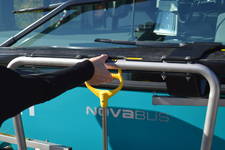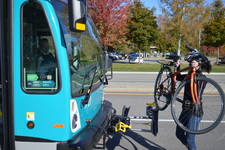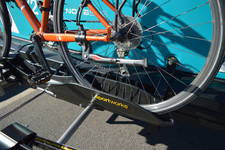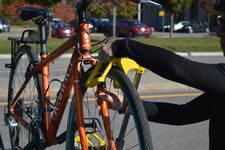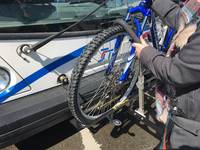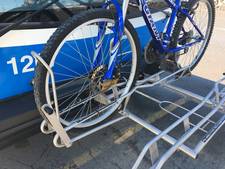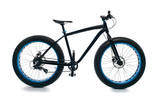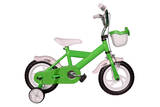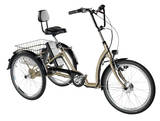Vélo-bus
Ride your bike for part of your trip, and then board a bus with your bike to your destination.
The Vélo-bus service is now guaranteed during the whole year as part of a pilot project, on ALL articulated and hybrid buses and on the following bus routes:
Service available | Route |
|---|---|
Monday to Friday | 31 - 36 - 37 - 38 - 49 - 55 - 59 - 68 - 371 - 400 |
Saturday and Sunday | 31 - 37 - 38 - 49 - 55 - 59 - 371 - 400 |
It is important to know that even if the service is now offered during the winter as well, “Fat bike” type bicycles are not accepted on the bike racks, due to the size of their wheels.
Please note that during winter the bike racks mechanism may freeze. In some cases, it may be impossible to use the bike rack.
Create your itinerary with the Plani-Bus.
Select the « Bike on bord » option service.
![]()
How to use the Vélo-bus service
See the video (in French only):
Loading
To do before the bus arrives
At your stop, you must remove all accessories from your bike (bags, water bottles, panniers, child seat, locks, etc.) so as not to block the driver's visibility. If you do not remove these items, the driver may refuse to let you use the bike rack.
As the bus approaches, indicate to the driver that you plan to use the service.
1. Open the rack
Gently push the bike rack towards the bus and then pull the handle to lower the rack to a horizontal position.
2. Load your bike
Lift your bike and place the wheels in the wheel wells. The first bike must always use the space at the back, which is the one closest to the bus.
3. Secure your bike
Depending on the type of bike rack:
Hook type: Extend and lift the hook arm as high as possible over the front tire of your bike. Make sure it is not touching the bike fender or lock.
Lever type: Turn the crank handle until the lever holds the front wheel of your bike.
Board the bus and pay your fare!
Unload your bike
- Before you reach your stop, tell the driver that you will be unloading your bike. IMPORTANT: as it is recommended, riders must disembark from the rear doors;
- If it's possibile, exit the bus from de rear door door.
- Depending on the bike rack, lower the hook arm to the horizontal position or turn the crank handle to release the wheel.
- Unload your bike.
- If the rack is empty, raise it and ensure that it is locked in place.
- Move away from the bus and signal to the driver that you have finished.
You are the second cyclist to use the rack
When there is already another bike in the rack, use the free space.
For example, if the front space is occupied, place your bike in the back space. Your bike should face in the opposite direction of the bike in the other rack.
You must follow the same steps to secure your bike.
See the video (in French only):
Come try the bike rack

On the STO network
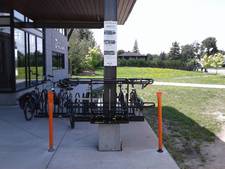
We have installed a permanent three demo structures so that you can take a closer look and try it out:
Bring your bike!
- at De la Gappe Rapibus station (between the Rapibus corridor (Ottawa direction) and Turin, near the bike racks on the ground. See the map)
- at Montcalm Rapibus station (platform on Montcalm)
- at the Rivermead Park-and-Ride (at the bike shelter)
Tips and safety rules
- You must be able to load your bike on the rack by yourself, without help from the driver.
- The racks can accommodate standard bikes with wheels that are at least 20 inches in diameter. See the bikes that are not permitted.
- You may not bring your bike into the bus with you.
- At your destination, don't forget to unload your bike!
See the video (in French only):
Bikes that are not permitted
Bikes with oversized wheels (fat bike), electric bikes (over 55 pounds), small children's bikes, tricycles, tandems and any other bikes with non-standard dimensions are not permitted. Please note that all bikes over 55 pounds are not accepted.
Below are some examples of bikes that are not permitted:
High school students using the STO's integrated transportationondaire utilisant le transport intégré de la STO
If you are eligible for the STO's integrated transportation you can use the Vélo-bus service when the bus has a bike rack. However, when classes end in the afternoon, for safety reasons, the Vélo-bus service cannot be used on school grounds. You must ride your bike to the first stop served on your bus route to be able to use the service.
Service details
- The service is now available during the whole year.
- The service is guaranteed on certain bus routes.
- There are no additional fees, this service is included in your fare.
- There is a limit of two bikes per rack, first come, first served!
- You can use the service at any time of day.
Because of the front design of some vehicles, bike racks can be installed only on certain 2009 or more recent bus models. All buses built in 2010 or later have a rack. The Vélo-bus service will therefore evolve over the years.
Did you forget your bike on the bike rack?
Contact Customer Relations to get your bike.
Useful links
Liability
The STO shall not be liable for any bodily harm, theft, loss or damages that may be caused by the transportation of bikes, or the handling and use of bike racks by riders on its buses.



